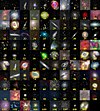NGC 7814
| Galaxie NGC 7814 | |
|---|---|
(c) ESA/Hubble, CC BY 4.0 | |
| Aufnahme des Hubble-Weltraumteleskops | |
| AladinLite | |
| Sternbild | Pegasus |
| Position Äquinoktium: J2000.0, Epoche: J2000.0 | |
| Rektaszension | 00h 03m 14,890s[1] |
| Deklination | +16° 08′ 43,50″[1] |
| Erscheinungsbild | |
| Morphologischer Typ | SA(s)ab: sp/LINER[1] |
| Helligkeit (visuell) | 10,8 mag[2] |
| Helligkeit (B-Band) | 11,6 mag[2] |
| Winkelausdehnung | 5,5′ × 2,3′[2] |
| Positionswinkel | 135°[2] |
| Flächenhelligkeit | 13,4 mag/arcmin²[2] |
| Physikalische Daten | |
| Zugehörigkeit | NGC 7814-Gruppe[1] |
| Rotverschiebung | 0,003506 ± 0,000005[1] |
| Radialgeschwindigkeit | (1.051 ± 1) km/s[1] |
| Hubbledistanz H0 = 73 km/(s • Mpc) | (54 ± 4) · 106 Lj (16,5 ± 1,2) Mpc [1] |
| Durchmesser | 90.000 Lj[3] |
| Geschichte | |
| Entdeckung | Wilhelm Herschel |
| Entdeckungsdatum | 8. Oktober 1784 |
| Katalogbezeichnungen | |
| NGC 7814 • UGC 8 • PGC 218 / 1501809 • CGCG 456-024 • MCG +03-01-020 • IRAS F00006+1552 • KUG 0000+158 • 2MASX J00031494+1608428 • GC 5046 • H II 240 • h 2297 • GALEXASC J000314.98+160842.4 • HIPASS J0002+16b NSA 126092 • WISEA J000314.91+160843.1 | |
NGC 7814 ist eine spiralförmige Radiogalaxie vom Hubble-Typ Sab in edge-on Stellung. Sie liegt in der Nähe des Sternes Algenib (γ Pegasi) im Sternbild Pegasus nördlich des Himmelsäquators. Die Galaxie ist schätzungsweise 54 Millionen Lichtjahre von der Milchstraße entfernt und hat einen Durchmesser von etwa 90.000 Lichtjahren. Sie entfernt sich vom Sonnensystem mit einer errechneten Radialgeschwindigkeit von näherungsweise 1.000 Kilometern pro Sekunde.
Die Spiralarme erscheinen hier nur als dunkle staubhaltige Wolken, beleuchtet von ihrem hellen Zentrum. Aufgrund der Ähnlichkeit mit Messier 104 wird NGC 7814 auch „Kleine Sombrerogalaxie“ genannt.
Sie ist Namensgeber der NGC 7814-Gruppe, ihr gehören unter anderem die Galaxien NGC 14, PGC 38, PGC 332 und PGC 889 an.
Anfang Juli 2021 wurde hier die Typ-Ia-Supernova SN 2021 rhu beobachtet.[4]
Das Objekt wurde am 8. Oktober 1784 vom deutsch-britischen Astronomen Wilhelm Herschel entdeckt.[5]
- Amateuraufnahme von NGC 7814; der helle Stern rechts oben ist HD 225001 die Galaxie unten IC 5381.
Galaktisches Umfeld
| Nr. | Galaxie | Alternativname | Rek | Dek | Distanz/asec |
|---|---|---|---|---|---|
| →[6] | NGC 7814 | LEDA/PGC 218 | 00h03m14.890s | +16d08m43.50s | 0 |
| 1 | LEDA/PGC 1502345 | WISEA J000328.07+161000.3 | 00h03m28.067s | +16d10m00.37s | 205.00 |
| 2 | LEDA/PGC 1504510 | 2MASX J00031045+1615263 | 00h03m10.45s | +16d15m26.2s | 408.24 |
| 3 | LEDA/PGC 1500064 | 2MASX J00025126+1604227 | 00h02m51.242s | +16d04m23.00s | 429.67 |
| 4 | LEDA/PGC 259 | NSA 25900 | 00h03m44.321s | +16d11m12.73s | 449.01 |
| 5 | 2MASX J00025195+1603137 | WISEA J000251.95+160314.2 | 00h02m51.965s | +16d03m14.16s | 466.73 |
| 6 | LEDA/PGC 212453 | WISEA J000308.14+155837.2 | 00h03m08.139s | +15d58m37.25s | 615.03 |
| 7 | IC 5381 | LEDA/PGC 212 | 00h03m11.270s | +15d57m56.56s | 648.42 |
| 8 | LEDA/PGC 1500199 | 2MASX J00022725+1604426 | 00h02m27.280s | +16d04m42.50s | 727.65 |
| 9 | LEDA/PGC 1498785 | NSA 25903 | 00h04m00.793s | +16d01m10.45s | 800.73 |
| 10 | LEDA/PGC 1496485 | 2MASX J00030655+1555243 | 00h03m06.588s | +15d55m24.77s | 806.84 |
Literatur
- König, Michael & Binnewies, Stefan (2019): Bildatlas der Galaxien: Die Astrophysik hinter den Astrofotografien, Stuttgart: Kosmos, S. 109
Weblinks
- Michael Deger: Leserbild in Spektrum.de vom 2. Juni 2018
- SIMBAD Astronomical Database
- Dancing on the edge (engl.)
- CDS Portal
- CDS Portal
Einzelnachweise
Auf dieser Seite verwendete Medien
Autor/Urheber: Hewholooks, Lizenz: CC BY-SA 3.0
NGC 7814 in Pegasus Taken with 9.25 inch Schmidt Cassegrain and Digtital SLR Camera
(c) ESA/Hubble, CC BY 4.0
Dancing on the edge
Galaxies can take many shapes and be oriented any way relative to us in the sky. This can make it hard to figure out their actual morphology, as a galaxy can look very different from different viewpoints. A special case is when we are lucky enough to observe a spiral galaxy directly from its edge, providing us with a spectacular view like the one seen in this picture of the week.
This is NGC 7814, also known as the “Little Sombrero”. Its larger namesake the Sombrero Galaxy is another stunning example of an edge-on galaxy — in fact, the “Little Sombrero” is about the same size as its bright namesake at about 60 000 light-years across, but as it lies further away, it appears smaller in the sky.
NGC 7814 has a bright central bulge and a bright halo of glowing gas extending outwards into space. The dusty spiral arms appear as dark streaks. they consist of dusty material that absorbs and blocks light from the galactic centre behind it. The field of view of this NASA/ESA Hubble Space Telescope image would be very impressive even without NGC 7814 in front; nearly all the objects seen in this image are galaxies as well.
A version of this image was entered into the Hubble’s Hidden Treasures image processing competition by contestant Josh Barrington. Links
Josh Barrington’s Hidden Treasures entry on Flickr
Credit: ESA/Hubble & NASA Acknowledgement: Josh Barrington
About the Object
Name: NGC 7814
Type: • Local Universe : Galaxy : Type : Spiral
• X - Galaxies Images/Videos
Distance: 40 million light years
Constellation: Pegasus
Colours & filters Band Wavelength Telescope Infrared I 814 nm Hubble Space Telescope ACS Optical V 606 nm Hubble Space Telescope ACS.
Autor/Urheber: Roberto Mura, Lizenz: CC BY-SA 3.0
Caldwell Catalogue objects.





